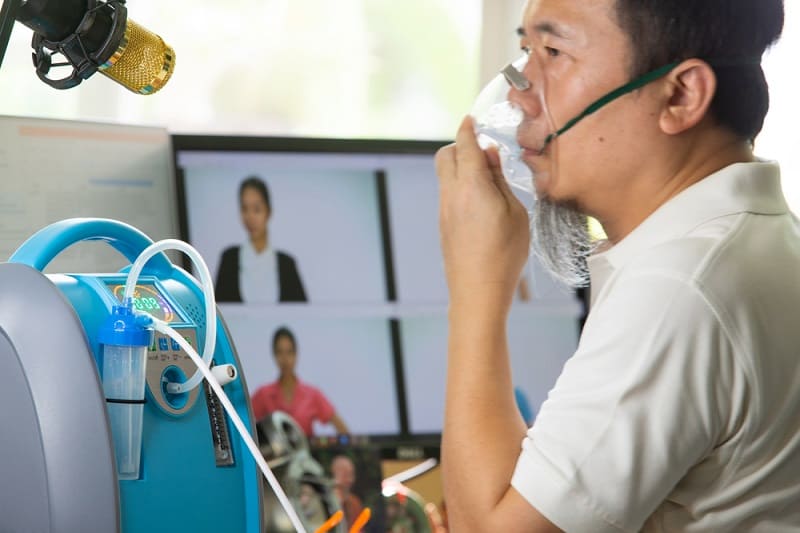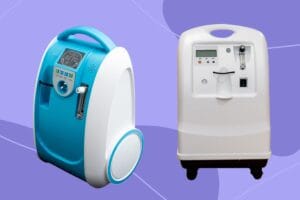What is an oxygen concentrator?
An oxygen concentrator is a medical device that takes in air from the surrounding environment, removes nitrogen and other gases, and delivers concentrated oxygen to the patient through a nasal cannula or mask. It is commonly used to treat patients with respiratory disorders who need supplemental oxygen, such as those with chronic obstructive pulmonary disease (COPD) or pneumonia.
What is the medical oxygen concentrator used for?
Medical oxygen concentrators are devices that generate oxygen from the surrounding air to provide a constant and reliable supply of oxygen to patients who have difficulty breathing. These devices are used for people with various respiratory disorders such as chronic obstructive pulmonary disease (COPD), asthma, cystic fibrosis, and emphysema, among others.
People who have low oxygen levels in their blood, also called hypoxemia, may require oxygen therapy to help them breathe easier. This is where medical oxygen concentrators come in. They are used to increase the oxygen levels in the patient’s bloodstream and alleviate the symptoms of hypoxemia, such as shortness of breath, fatigue, and headaches.
Overall, medical oxygen concentrators are essential for people who have difficulty breathing due to respiratory disorders or other medical conditions that cause hypoxemia. They provide a reliable and consistent supply of oxygen, making it easier for patients to breathe and carry out their daily activities.
Advantages of using an oxygen concentrator :
- Increased mobility: Oxygen concentrators are portable, which allows individuals to move around and perform daily activities without being confined to a stationary location.
- Cost-effective: Oxygen concentrators are more cost-effective in the long run compared to oxygen tanks since they only require electricity to operate and do not need to be refilled.
- Continuous supply of oxygen: Unlike oxygen tanks that need to be refilled periodically, oxygen concentrators produce a continuous supply of oxygen.
- User-friendly: Oxygen concentrators are easy to use, and the flow of oxygen can be adjusted as per the requirement.
- Reduced risk of infection: Oxygen concentrators do not require constant maintenance, which reduces the risk of infection and other health hazards.
- Low noise level: Oxygen concentrators are relatively silent compared to other oxygen delivery systems, which can be a significant benefit for individuals who are sensitive to noise.
- Environmentally friendly: Oxygen concentrators do not produce any hazardous waste, making them more environmentally friendly compared to oxygen tanks.
Here are the general steps for using a medical oxygen concentrator:
- Place the concentrator in a well-ventilated area with sufficient space around it for proper airflow.
- Connect the oxygen tubing to the concentrator’s outlet.
- Attach the other end of the tubing to the nasal cannula or mask.
- Turn on the concentrator and adjust the flow rate as prescribed by your healthcare provider.
- Position the nasal cannula or mask over your nose and mouth, ensuring a secure fit.
- Breathe normally, taking deep breaths as needed.
- Keep the concentrator clean and maintain it as directed by the manufacturer.
It’s important to follow your healthcare provider’s instructions for using a medical oxygen concentrator and to never change the flow rate without their approval. If you have any questions or concerns, consult your healthcare provider or the manufacturer’s instructions.
There are two main types of medical oxygen concentrators :
1.Stationary oxygen concentrators: These are larger units that are designed to provide a continuous flow of oxygen, and are typically used in a home or clinical setting. They are not portable and require a direct power source to operate.
Stationary oxygen concentrators are medical devices that deliver concentrated oxygen to patients suffering from respiratory problems such as COPD, emphysema, and chronic bronchitis. These devices are designed to extract oxygen from the surrounding air and deliver it to the patient via a mask or nasal cannula. They are typically used in homes, clinics, and hospitals to treat patients who require a continuous supply of oxygen.
Stationary oxygen concentrators are highly efficient and reliable, offering a constant flow of oxygen to patients with minimal noise and vibration. They are easy to operate and require minimal maintenance, making them an ideal choice for home use. They come in a variety of models, with different flow rates, capacities, and features to suit the individual needs of patients.
One of the major advantages of stationary oxygen concentrators is that they do not require the constant replacement of oxygen tanks, which can be expensive and inconvenient. With a stationary oxygen concentrator, patients can enjoy a continuous supply of oxygen without worrying about running out of oxygen or having to replace tanks.
Overall, stationary oxygen concentrators are an essential medical device for patients who require a continuous supply of oxygen. They offer a safe, effective, and convenient way to manage respiratory problems, improving patients’ quality of life and reducing the risk of complications.
2.Portable oxygen concentrators: These are smaller, lightweight units that can be taken on-the-go and are powered by batteries or by plugging into a wall outlet. They typically provide a pulse dose of oxygen, which means they only release oxygen when the user inhales. Portable oxygen concentrators are a popular choice for people who need oxygen therapy while maintaining an active lifestyle.
Portable oxygen concentrators are medical devices that help people with respiratory issues to breathe more easily. They work by extracting oxygen from the surrounding air and delivering it directly to the patient through a mask or nasal cannula. The devices are small and lightweight, making them easy to carry and use wherever you go. They are ideal for people who need oxygen therapy when they travel or engage in physical activities.
One of the biggest advantages of portable oxygen concentrators is that they don’t require refills like traditional oxygen tanks. They run on rechargeable batteries or AC/DC power sources, so they can be used even when you’re on the go. They are also designed to be quieter than traditional oxygen tanks, so you won’t disturb others around you when you use them.
Portable oxygen concentrators come in different models and sizes, and the right one for you will depend on your specific needs. Some models are designed for continuous use, while others are designed for use during exercise or when you need a boost of oxygen. You should consult with your doctor or respiratory therapist to determine the best model for you.
Overall, portable oxygen concentrators are a convenient and effective way to get the oxygen you need when you need it. They offer freedom and mobility to those who require oxygen therapy, making it easier to live a normal, active life.
Here is a price list for Medical Oxygen Concentrator in Bangladesh :
- 10L Olive Oxygen Concentrator – ৳ 82,000/-
- 5L Olive Oxygen Concentrator – ৳ 50,000/-
- AE-5 Areti Oxygen Concentrator – ৳ 49,500/-
- ARETI AE-8-S Portable Oxygen Concentrator – ৳ 84,000/-
- DEDAKJ Portable Oxygen Concentrator – ৳ 35,000/-
- Folee 10l Oxygen Concentrator – ৳ 50,000/-
- Konsung KSN-5 5L Portable Oxygen Concentrator – ৳ 38,000/-
- Longfian JAY-10 10L Home Oxygen Concentrator – ৳ 80,000/-
- Longfian JAY-1A Portable Oxygen Concentrator – ৳ 115,000/-
- Longfian JAY-5AW Home Care Oxygen Concentrator – ৳ 45,000/-
A medical oxygen concentrator is a device that takes in ambient air and removes nitrogen and other gases to produce concentrated oxygen that can be used for medical purposes. It is designed to provide a continuous and reliable source of oxygen to patients with respiratory conditions, such as chronic obstructive pulmonary disease (COPD) or pneumonia, who require supplemental oxygen therapy.
Medical oxygen concentrators can be used in hospitals, clinics, and at home, and come in a range of sizes and flow rates to meet the needs of different patients. They are generally considered safe and cost-effective compared to traditional oxygen delivery systems that rely on Oxygen cylinders or tanks.



